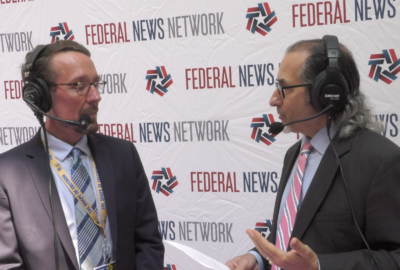Why the Defense Department’s worldwide network will have to be a living system
It's become nearly cliché in Defense circles, that the near military peers of the United States are more than near. We're all neck-in-neck. Discussions of gett...
Best listening experience is on Chrome, Firefox or Safari. Subscribe to Federal Drive’s daily audio interviews on Apple Podcasts or PodcastOne.
It’s become nearly cliché in Defense circles, that the near military peers of the United States are more than near. We’re all neck-in-neck. Discussions of getting back to U.S. superiority all include the need for a more digital approach, a digital transformation. At the center of that discussion you find the Defense Department’s vision for a new network known as Joint All-Domain Command and Control, known as JADC2. The Federal Drive with Tom Temin spoke to someone with some ideas for JADC2. He’s the former deputy Air Force chief information officer, now a managing director at Accenture Federal Services, Bill Marion.
Interview transcript:
Tom Temin: Good to know you’re up to your old tricks just from the commercial side as opposed to the government side, but kind of all oars pulling in the same direction here. Just talk for a minute about how a network can be or should be considered as strategic a piece of defense as the new bomber coming along or something like that.
Bill Marion: When I describe a network, it’s a network of capabilities, not as much the what we traditionally have called the network of routers, switches and hubs that just connect us at the lowest level, right? It’s the network, we call it connecting your cloud ecosystem, your digital platforms, your talent ecosystem, frankly, is part of that network, your core network. So whether that’s a 5G satellite constellation, it’s really how you orchestrate. I mean, to me, JADC2 is this master orchestration of these core service capabilities across a complete portfolio. That’s a great thing. But it’s also the risk of JADC2, how do you orchestrate a very complex system of systems approach?
Tom Temin: And you get the sense that they are developing, I mean, there’s a central JADC2 office, but then each armed service has its own office to make networks that are compatible with the architecture of JADC2, so a lot of moving parts. Do you sense that they are avoiding building something monolithic, that would be obsolete by the time they field it?
Bill Marion: I do think they’re staying away from the monolithic. I mean, you see the efforts like Cloud One and Platform One and ECMA, and Army Led Software Factory, these are all very agile, focused, decomposable, yet integrated elements of a bigger system. So I do think we’re making some significant progress there. Probably going into some challenges, but I think there’s some challenges of how you bring the specific services together into a holistic approach. So I think the building blocks are going in the right direction. But there’s some fundamental light switch flips that we need to do to really improve that interoperability. We’ve not yet fully gotten the full scope of true joint all domain, there really been pockets. These exercises have been successful. I think they’re bringing great mission capability forward. But we just haven’t really gotten into full orchestration, I think across all the services yet.
Tom Temin: Got it. And you have postulated the idea of a living system that is JADC2. And what do you mean by that?
Bill Marion: Frankly, it goes back to the, I call it the softer dimensions of success in IT. And we see this time and time again, in our client practices, human centered design, leveraging your talent, bringing a user experience what I call a mission experience to bear, it’s often very easy to buy a platform, it’s easy to buy a digital capability. The hard part is all the software dimensions of processes and integration and flows. And I call them playbooks and accelerators. We talk about living systems, it’s actually putting that living dimension to a very binary system, right? It’s not just the network, it’s not just the digital platform, it’s actually how you leverage the tools. If your people aren’t equipped to use them, if the processes aren’t there to actually accelerate them, if you’re not really using best practices for an industry to really gain the benefits that the investments have been there, you really don’t have a full living system. You don’t have the accelerators that really bring it to bear at the speeds that we need to against our atmosphere.
Tom Temin: We’re speaking with Bill Marion, he’s managing director at Accenture Federal Services, former Air Force deputy CIO. And ultimately, the purpose of this in the most basic sense is to move bits from here to there. And so there’s a lot of software, as you say, on top of this, the whole expression of what is expected for it, philosophically is software. But underneath that there is hardware, and there’s protocols, and so on. And so the problem, then, and I’m asking this as a question is, you need hardware, you need to connect wires, ultimately. But then that becomes obsolete also, at some point. The protocols change or the transport mechanisms and media change. And so how do you manage a project long term where you’ve got really two layers of it that are constantly in flux? One is the software and services you provide. But then you really need that plumbing underneath to be up to date also over time.
Bill Marion: Right. I think that the core challenge there that and this is a department issue is, I call it the lack of what we would call solution architects. The folks that can really take these decomposable technical capabilities. So we have cloud experts. We have digital platform experts, we have ERP experts, but those folks that really sit above that level that can take these individual silos that are interoperable, we just don’t necessarily weave them together well. And so that’s a talent issue. That’s an investment issue. One of the things I saw in my career prior to Accenture was, we really don’t do a good job funding those elements of people in developing those. And those are your top tier folks in your organization. Certainly, in Accenture, we invest heavily in that level of mindset. Things like the CRs and the budget challenges, those are the people that typically get cut first, because the silos are delivering, right? So keep delivering, keep delivering, but we cut from these solution architects, these people that actually bring the full integration together.
So I mean, if there was a budgetary thing that I had a day with Congress, that would be a big focus of the talent management and the development and the resourcing, and really the retention of that skilled labor. Because we have a lot of technical capabilities. We have a lot of great air platforms. What ultimately wins wars is how you bring the fight together, not whether we have the best tanker, whether we have the best fighter or whether we have the best ISR. It’s about how we do again, all domain command and control.
Tom Temin: And underneath that all as you write is the acquisition system, which has to be equally quick and agile. And that hasn’t always been the case in everything that the DoD buys.
Bill Marion: Absolutely. And I think there’s, again, there’s been substantial movement forward using OTAs, sippers, other tools in the toolbox. I think the toolbox has expanded. I definitely again see at these large scale initiatives, we have not figured that out yet. Things are better. I’m not about to say they’re not better. I give a lot of the acquisition leads credit for that. Like in the Air Force side, you know, Dr. Roper, Costello, some of those folks in that ecosystem. But there’s still a cultural piece below that level of how you deliver in an agile construct. We have several pretty large DoD agile programs. We still get reverted back to administrative checking of reports and those kind of things, which really aren’t tenets of agile, right? It’s understanding you’re only going to get 89%, but you’re gonna deliver faster, better, leaner. So some of those things are still areas for improvement inside the government.
Tom Temin: And the implication of fast agile scrums and developing in stages like that implies that there is a great deal of interaction with the people that are going to live with the resulting system. So it sounds like you’re saying that there needs to be the warfighters literally involved in each module, because they’re the ones that have to actually operate it. Think of the forces massing in case something happens in Russia, for example. There’s a real example of where some type of network would need to enable them.
Bill Marion: Absolutely. And we have multiple clients that are engaging like that now, which is very refreshing. Because again, that gets back to the living systems like how to get the human dimension, because at the end of the day that warfighter is going to have to use that tool. It’s not this core 50 page requirements document that was created five years prior, right? So I do see good traction there. What I’m saying is there’s a there’s a larger cultural piece of just how you maneuver through that agile framework, that’s still has got some maturation to do.
But I definitely see defense clients today starting to leverage more of the agile constructs. And we really enforce it as a practice and as some of our competitors do as well, because it’s just so fundamental to actually getting things right, frankly. That the five year build a requirement process is antiquated after year one, and you still spend four more years working the requirements document. So it’s just a failed model. I think we’re past that. But we still got, I would say there’s probably 40% of the market that is doing agile constructs. We still got some room to go.
Tom Temin: Sure. And a final question on the recommendation, you have a long list here. Embrace human centered design. I think you mentioned that briefly. But that’s not just a nice thing with a good looking interface. But really something that people in stressful situations can get what they want out of without dealing with the interface itself.
Bill Marion: Absolutely. And it’s really two I kind of put them in two dimensions, the human centered design, there’s also that part of agile right? How do you work with the warfighter? How do you work with that airman, guardian, seaman, whatever the case may be, to imagine what that journey looks like. What that system should, how it should operate in a contested environment. Then you have the other element of, again, how that system actually is executed, how you use agile concepts to really improve the look and feel. And again, you’re trying to take that friction out. And so you only get friction out not by paper documentation requirements, you get that friction out by actually iterating with the user, iterating in these HCD sessions. And again, that can be either from a requirement perspective before the system’s built, or as it’s being delivered and modernized through the years. You certainly don’t want to get in this deliver and forget. That’s another concept. We still have some room to go, right? We still do the hey, we went out of C and we’re done.
Tom Temin: All right, Bill Marion is managing director at Accenture federal services, and a former Air Force deputy CIO, thanks so much for joining me.
Bill Marion: Thanks, Tom. I appreciate it.
Copyright © 2024 Federal News Network. All rights reserved. This website is not intended for users located within the European Economic Area.
Tom Temin is host of the Federal Drive and has been providing insight on federal technology and management issues for more than 30 years.
Follow @tteminWFED






